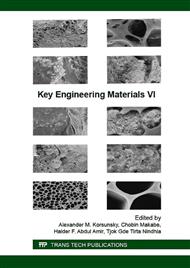[1]
S. Liu, X. Liu, S. Latthe, L. Gao, S. An, S. Yoon, B. Liu , R. Xing, Self-cleaning transparent superhydrophobic coatings through simplesol–gel processing of fluoroalkylsilane, Appl. Surf. Sci. 351 (2015) 897–903.
DOI: 10.1016/j.apsusc.2015.06.016
Google Scholar
[2]
W. Hu, Y. Yu, H. Chen, K. Lau, V. Craig, F. Brink, R. L. Withera, Y. Liu, Synthesis and chemical modifications of in-situ grown anatase TiO2microspheres with isotropically exposed {0 0 1} facets forsuperhydrophobic and self-cleaning properties, Appl. Surf. Sci. 357 (2015).
DOI: 10.1016/j.apsusc.2015.09.179
Google Scholar
[3]
D. Kumar , X. Wu, Q. Fua, J. Weng, C. Ho, P. D. Kanhere, L. Li, Z. Chen, Hydrophobic sol–gel coatings based on polydimethylsiloxane for self-cleaning applications, Mater. Design 86 (2015) 855–862.
DOI: 10.1016/j.matdes.2015.07.174
Google Scholar
[4]
R. Zheng, M. Tshabalala, Q. Li, H. Wang, Construction of hydrophobic wood surfaces by room temperaturedeposition of rutile (TiO2) nanostructures, Appl. Surf. Sci. 328 (2015) 453–458.
DOI: 10.1016/j.apsusc.2014.12.083
Google Scholar
[5]
B. Li, L. Huang, N. Ren, X. Kong, Laser ablation processing of zinc sheets in hydrogen peroxide solution for preparing hydrophobic microstructured surfaces, Mater. Lett. 164 (2016) 384–387.
DOI: 10.1016/j.matlet.2015.11.035
Google Scholar
[6]
N. Patil, R. Bhardwaj, A. Sharma, Droplet impact dynamics on micropillared hydrophobic surfaces, Exp. Therm Fluid Sci. 74 (2016) 195–206.
DOI: 10.1016/j.expthermflusci.2015.12.006
Google Scholar
[7]
C. Zhang, S. Zhang, P. Gao, H. Ma, Q. Wei, Superhydrophobic hybrid films prepared from silica nanoparticles and ionic liquids via layer-by-layer self-assembly, Thin Solid Films 570 (2014) 27–32.
DOI: 10.1016/j.tsf.2014.08.045
Google Scholar
[8]
Y. Huang, D.K. Sarkar, X. Grant Chen, Superhydrophobic aluminum alloy surfaces prepared by chemicaletching process and their corrosion resistance properties, Appl. Surf. Sci. 356 (2015) 1012–1024.
DOI: 10.1016/j.apsusc.2015.08.166
Google Scholar
[9]
T. Ishizaki, J. Hiedab, N. Saitoc, N. Saitoa, O. Takai, Corrosion resistance and chemical stability of super-hydrophobic film deposited on magnesium alloy AZ31 by microwave plasma-enhanced chemical vapor deposition, Electrochim. Acta 55 (2010).
DOI: 10.1016/j.electacta.2010.06.064
Google Scholar
[10]
Y.H. Sunga, Y.D. Kima, H. Choia, R. Shinb, S. Kang, H. Lee, Fabrication of superhydrophobic surfaces with nano-in-microstructures using UV-nanoimprint lithography and thermal shrinkagefilms, Appl. Surf. Sci. 349 (2015) 169–173.
DOI: 10.1016/j.apsusc.2015.04.141
Google Scholar
[11]
L. Xie, Z. Tang, L. Jiang, V. Breedveld, D. Hess, Creation of superhydrophobic wood surfaces by plasma etching and thin-film deposition, Surf. Coat. Technol. 281 (2015) 125–132.
DOI: 10.1016/j.surfcoat.2015.09.052
Google Scholar
[12]
Q. Li, Y. Wang, C. Rong, F. Zhang, Y. Liu, L. Chen, Q. Wang, C. Peng, Facile assembly of graphene and titania on micro-structured substrates for superhydrophobic surfaces, Ceram. Int. 42 (2016) 2829–2835.
DOI: 10.1016/j.ceramint.2015.11.018
Google Scholar
[13]
A. Kessman, D. R. Cairns, Template-assisted encapsulation of fluorinated silanes in silica films for sustained hydrophobic–oleophobic functionality, J. Colloid Interface Sci. 360 (2011) 785–792.
DOI: 10.1016/j.jcis.2011.05.026
Google Scholar


